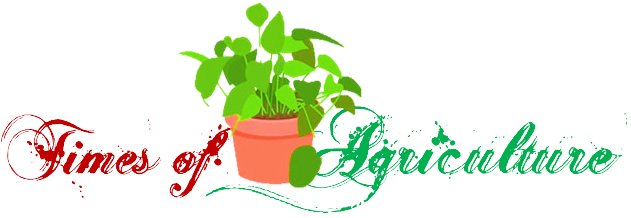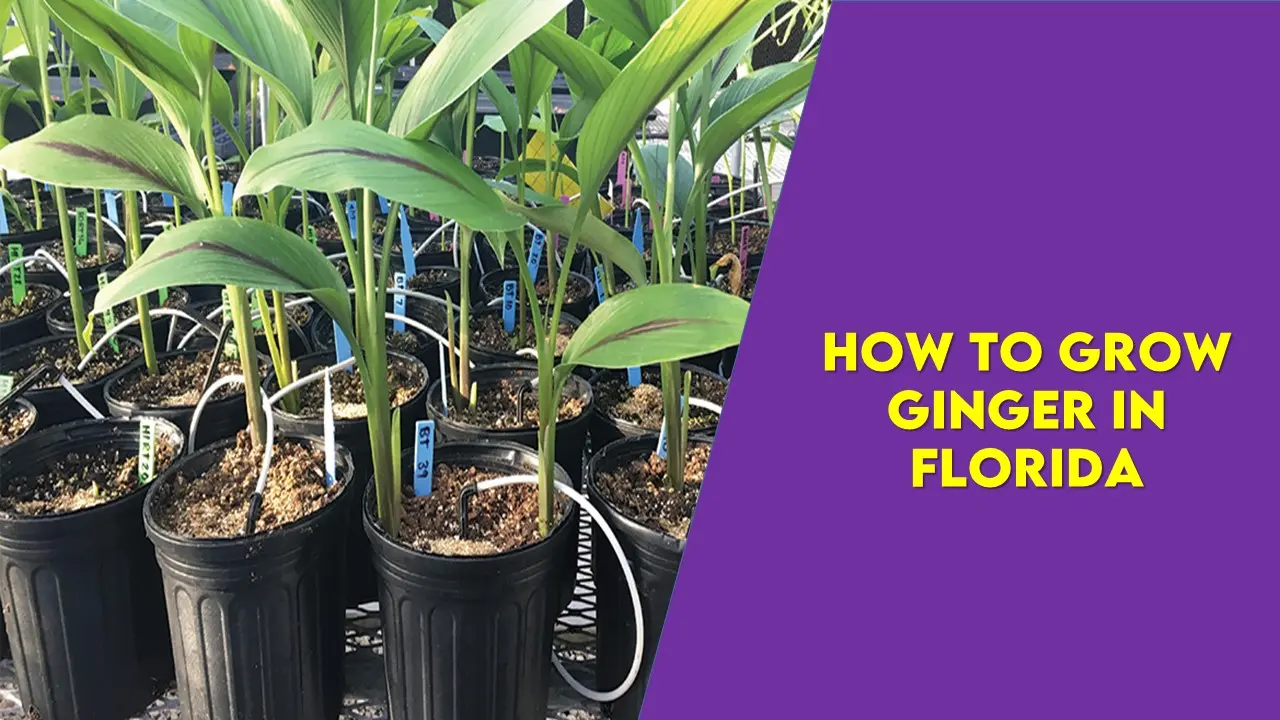How to Grow Ginger in Florida: Thriving with Zen in 21st Century
To fill the epicentre of entertainment with some spice, Let’s know how to grow ginger in Florida.
Florida, a peninsula located in the southeastern United States, is known for its castles, its history in Hollywood, theme parks and wonderful beaches. But little do we know that the warm and humid climate in this region also offers great opportunities for growing many agricultural commodities like Ginger. However, it is not known to be cultivated commercially in the region.
Ginger is a perennial plant that has been a part of our food and medicine for thousands of years for its many antioxidants and anti-inflammatory properties. It is still known to be used by people in their dishes for its underground rhizomes. But the ornamental varieties of ginger are also known in this region, which are available in all colours, shapes and sizes like Butterfly Gingers, Peacock Gingers, Landscaping in the Shade, Shampoo Ginger, or Spiral Gingers.
Factors Affecting Ginger in Florida
The major part of Florida is considered to be a humid subtropical region. Yet the frequent and harsh weather conditions with chances of water scarcity and chilling injury should be kept in mind while growing Ginger in Florida. To meet the requirements of growing edible Ginger(Zingiber officinale) along with the changing climatic conditions, the following factors are important :
Climate
It is suggested to grow ginger in Florida in spring. It produces well if it gets a few hours of sunlight in a day(less than 11 hours), though it thrives well in full shade as well. Edible ginger in Florida grows best in partial shade(25%). If the ginger is grown as a short-day plant, there will be profuse growth of rhizome and lesser growth of other vegetative parts, and the opposite will occur if the plant is grown as a long-day plant(more than 11 hours).
It takes about nine to ten months until the rhizomes of Ginger fully develop. Harvesting of ginger should be done during fall or when the tops of ginger die. The ginger plant grows up to a height of two or three feet with narrow leaf blades and bright, green, lush foliage. Flowering in this plant starts in autumn, and produces yellow, green, purple or pink-tipped flowers.
Soil and Irrigation
Ginger in Florida thrives well in rainfed as well as irrigated areas. But a suitable amount of water is needed by the crop from the time of sowing till sprouting and a moderate amount of water(1300-1500 mm) at the growing period. However, it is necessary to provide at least a month of dry period before harvesting.
One most important criteria is, well-drained soil like sandy loamy, laterite loamy etc, as ginger is sensitive to rotting in water-logged conditions. An even mixture of sand and manure could be used in soil with low organic matter. In places receiving high rainfall, try growing ginger in a raised bed and a soil mixture at least 8 inches deep. Also, a pH between 5.5 and 6.5 should be maintained during the whole life of the crop in the soil and soil organic matter also enhances the growth of ginger.
Ginger is an exhaustive crop, so it is not recommended to grow it year after year on the same land. Rather practise thinning than fully harvesting it, if you want to obtain a ginger crop in the upcoming year as well.
Planting or Sowing
It is rare to grow ginger in Florida from seeds. Instead, it is recommended and available that Ginger should be cultivated from ‘Rhizome seeds’ only.
- Plant 1.5-inch pieces of rhizome in an inch below the soil.
- If we cut a large rhizome piece and it is not for planting purposes, then dry the pieces indoors for a few days to prevent rotting.
- Apply a seed rate of 1500 – 1800 kg of rhizome/ha is required with a spacing of 15 inches.
- Irrigate it as per the requirements.

Ginger Transplanting
Ginger transplanting is not conventional but the technique could be exploited for commercial purposes by using bud sprouts of 5 grams to produce good quality planting material with lesser cost. The yield obtained through transplanting is much higher than the conventional method.
First, raise the plant from a single sprout seed rhizome and plant it in the field after thirty to forty days. Other than input cost reduction and higher yield, transplanting also helps in the production of disease-free rhizomes.

Manure and Fertilizers
It is best to use organic manure for the cultivation of Ginger in Florida. Cattle manure or compost should be applied either by broadcasting before planting or applied in the pits at the time of planting @ 25-30 tonnes/ha. Application of neem cake @ 2 tonnes/ha at the time of planting can also help in decreasing the incidence of rot disease or nematodes and leads to good yield.
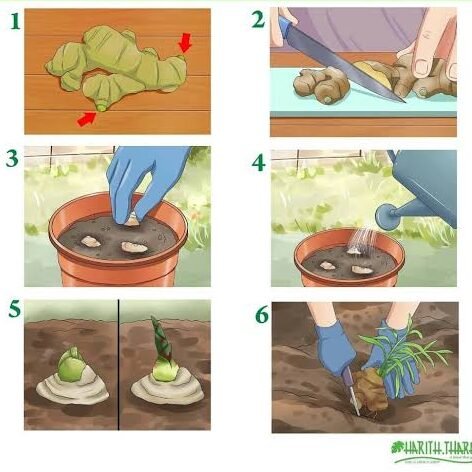
If the soil is deficient in nutrients then a recommended dose of nutrients N, P and K should be applied. Equal split doses of N and K are used for top dressing @ 45, 90 (and 120) DAP and two other top dressings. In Zinc deficient soils, basal application of zinc fertilizer up to 6 kg zinc/ha or zinc sulphate @30 kg/ha.
Kaolin sprays every two weeks also enhance the growth of the ginger plant. It was a proven experiment in Florida that Kaolin Spray can increase the yield by 87%.
Mulching
Covering the beds with green leaves/organic wastes can be done to prevent soil splashing and retain soil moisture, which makes it quite a useful practice to grow ginger in Florida that could experience water-scarce conditions. It also adds organic matter to the soil, preventing weed emergence. The first mulching is done at the time of planting @ 10-12 tonnes/ha. The application of dried coconut leaves after paddy straw as mulch in ginger is also recommended for effective weed control. It should be done regularly @ 7.5 tonnes/ha in 45-90 days after planting.
Inter Cultivation
Weeding
Ginger needs around 2-3 hand weeding just before the application of fertilizer or mulching. The number of weddings also depends upon the intensity of weeds.
Earthing up
Earthing up is done to minimise the rhizome’s exposure to sunlight and to provide good volume for its development. It is done at 45 and 90 days after planting and must be done after fertiliser application and mulching.
Crop Rotation
Crop rotation in ginger is done along with paddy, ragi maize and some vegetables.
Diseases Control while Growing Ginger in Florida
In the climatic conditions of Florida, commercial losses through diseases are minimal and can be managed by biocontrols only. But in case of open conditions, if a high infestation occurs, the following measures can be adopted.
Soft Rot
Soft rot is soil-borne and the most destructive disease of ginger which may result in the total loss of affected plants. It can be caused by Pythium spp. among which, P. aphanidermatum and P. myriotylum. Young sprouts and seedlings are susceptible to this disease.
Symptoms
The infections start from the collar region and progress towards the whole plant. The plant becomes water-soaked and spreads to rot the whole rhizome which also produces a foul smell. The leaves appear yellow in the margins. Yellowing spreads to all plant parts and leads to withering, and drying of pseudostem.
Management
- Select disease-free or certified planting material or seed.
- Select the land with a good drainage facility.
- Soil Solarisation for at least 45 days could be done to prevent the primary infection, as primary inoculum lies in soil debris.
- Treat the seeds with fungicides like Mancozeb or Metalaxyl @0.25% for 30 minutes.
- Biocontrol agent Trichoderma harzianum along with neem cake @1 kg/bed could also prevent the disease.
- In case the disease occurs, apply Mancozeb @0.25% or Copper Oxychloride@0.20%.
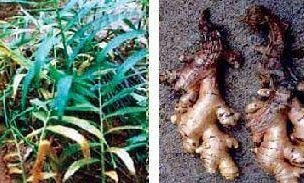
Bacterial Wilt
Bacterial wilt caused by Biovar-3. It is a soil-borne and seed-borne disease that occurs during heavy rainfall or waterlogged conditions.
Symptoms
The appearance of water-soaked lesions at the collar region occurs and then it spreads towards the whole plant. Drooping and curling of leaves are peculiar symptoms of the disease. Plants experience yellowing and wilting with dark streaks on vascular margins. When the affected plant part is pressed in the presence of water, oozing occurs with a foul smell.
Management
- The cultural practices could be adopted. Planting material should be taken from disease-free areas.
- Its inoculum survives in soil for many years, so It is not advisable to plant ginger consecutively in the same field every year.
- Remove and dispose of the affected plant debris.
- Apply Streptomycin or Copper Oxychloride @0.25%.

Leaf Spot
The leaf spot is caused by Phyllosticta zingiberi.
Symptoms
Water-soaked lesions surrounded by dark brown margin and yellow halo ring. The spot coalesces to form necrotic areas. It spreads through rain splashes.
Management
Spray a Bordeaux mixture @1% or carbendazim @0.2%. Spray on the lower surface of the leaf also.
Pests Control while Growing Ginger in Florida
Shoot borer
The shoot borer (Conogethes punctiferalis) is the most serious insect pest of ginger in Florida.
Symptoms
The larvae of the shoot borer feed in the internal tissues that result in yellowing and drying of the plant. The frass is excluded from the boreholes, which is a characteristic symptom of this pest. The pest population is higher in the field during September-October.
Management
- The spraying should be initiated when the first symptom appears in the field.
- The shoot borer can be managed by spraying Malathion @0.1% at 21 day intervals during the rainy season.
- Pruning and destruction of infected plant parts during the season and spraying Malathion again.
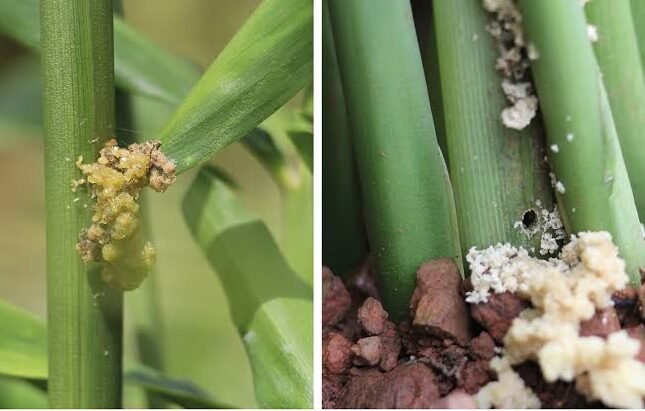
Rhizome Scale
The rhizome scale (Aspidiella hartii) is a field as well as a storage pest. It encrusts in rhizomes.
Symptoms
The scale feeds on plant sap and in severe infestation plant shrivels and enables germination.
Management
- Timely harvesting and discarding infested rhizomes and treating with Quinalphos @0.075% for thirty minutes before storage.
- The rhizome must be stored in sawdust with dry strychnos leaves.

Harvesting of Ginger
Ginger in Florida attains full maturity in about 7-8 months after planting, but for vegetable purposes, it can be harvested after 6 months. For dry ginger spice, ginger oil, etc, harvest the ginger only after maturity. In large farms, it can be done by cultivators for tractors, but manual handling is best to avoid damage in rhizomes. Late harvest can also be practised to let the rhizome dry in the field itself and avoid more labour.
For the domestic market fresh ginger could be used but for export, one should always prefer harvesting after attaining maturity. Important components like fibre, volatile oil and the pungency level also depend upon the time at which the ginger was harvested.
Post-Harvest Handling of Ginger in Florida
After harvesting, clean the soil, trim the roots and dry the stem. For disinfection, the rhizomes can be treated in Chlorine through Hydrogen Peroxide and Hypochlorite Beach @50 ppm. Curing in ginger rhizomes for at least three to five days toughens its skin and reduces weight loss during storage.
The disinfected Rhizome should be stored at 54°F to 57°F with 85% relative humidity to minimise drying. But a lower temperature than this can cause chilling injury. Any infected rhizome should be immediately removed while properly treated rhizomes can be stored for up to 90 days.
Ginger Market in Florida
There is a huge demand for ginger all over the world. In the USA the demand for ginger is 76 million dollars. Hawaiian rhizomes are preferable over Floridian rhizomes because Hawaii is located much closer to the equator with a huge market in the country. Rhizomes of Ginger in Florida have to compete with imported rhizome seeds from Hawaii. The retail price of imported mature rhizomes ranges from $1.40-6/lb. The fresh rhizomes can be sold as baby rhizomes at the rate of 8-20 US dollars/lb. The Rhizomes planted in Florida fields or containers yield about 1-2 pounds each. In upcoming years, Florida has the potential to become the best competitor in ginger production.
Conclusion
After examining the climatic conditions and topography of Florida, there is a huge opportunity to cultivate gingers and create a competitive market at the global level. As winter in in this region stays for a short time, and demand for ginger in Florida is less in the domestic market, it has a huge potential market in Asia and Europe.
Ginger has been planted in different regions around the world for about four thousand years and has been known for treating cough, cold, arthritis, menstrual flow, etc. Gingerol, an important compound in ginger, is also known for boosting our immune system and fighting against diabetes. Hence, People around the world cultivate ginger in many different ways, but through this article, we can learn about the most scientific and researched methods on how to grow Ginger in Florida along with its requirements and pitfalls.
Also Read:
